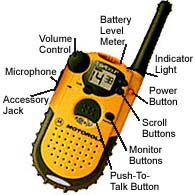
Gear Home Check out:
Marketplace
Contests
Auctions


|

|
It's my fate to travel with photographers. From Patagonia with Art Wolfe to Everest with Wally Berg, I've been told to stand here, no there, to do this, and to do that again.
But this time there's over a mile of deep, twisting Buckskin Gulch between me and famous landscape photographer James Martin. The Paria River of northern Arizona is a beautiful place, so I needed to get some distance on Martin before he found a good shot that called for a model. But just as I think I'm safe at last, the little TalkAbout Plus hanging off my pack crackles to life: "Peter, the light is just unreal, you've got to get back here and stand on this rock in the river for me..."
Motorola's TalkAbout Plus changed everything about outdoor communication. For the first time, an inexpensive two-way radio didn't mean an El Cheapo two-way radio. The TalkAbout Plus sports Motorola quality for a little more than a hundred bucks per. They're small, they stand up to abuse, and what's really amazing, they work.
The owner's manual states the range limit is about two miles, which in my experience is conservative. Martin, admittedly, had been lucky in the canyon, that's the worst possible terrain for reception, but even in an enclosed place such as the Paria, the range of these TalkAbout Plus units exceed expectations, and the quality of reception never ceases to amaze. In line-of-sight situations, such as on high, open mountain slopes, or between boats on open water, phenomenal range has been recorded.
 |
They have tremendous utility in the indoor arena as well. At trade shows such as Outdoor Retailer or Comdex, the small radios are ubiquitous. Cheaper and easier to use than cellular telephones, particularly among groups of three or more, they are perfect for large indoor gatherings, shopping malls, or sporting events such as football games. I sometimes use them walking the dogs with my wife, or even while shopping, where these radios can save a marriage by coordinating a rendezvous point.
The TalkAbout Plus and other personal radios operate on a special frequency (462-470 Mhz.) allocated by the Federal Communications Commission for family and recreational use. Because of that, no FCC licenses are required to own or operate the small devices. Since they hit the market almost two years ago, Motorola and other manufacturers have reported brisk sales of these "recreational" radios.
Functionally, the TalkAbout Plus is well designed. O-rings and sturdy plastic protect the unit from dust and abuse. They fit the hand well, and are simple to operate. The large Talk button is obvious, so once the unit is turned on and the channel and code selected, it is always in receive mode unless the talk button is pressed. I've discovered the TalkAbouts suck batteries at a miserly rate — a fresh load of three AAs will keep one operating on receive mode for more than 24 hours. If one does a lot of transmitting, however, battery usage increases dramatically.
My one complaint is that there is no means of attachment to harness or pack. So I removed the optional belt clip, and tied a loop of 3mm cord through the slot through which I could clip a 'biner. That's a great solution if you want to keep one handy, clipped to rack or pack. All manner of cases, headsets, and waterproof pouches are available, but I simply put 'em in Ziplock baggies inside a stuff sack when protection is called for.
As their popularity grows, one wonders if the band on which they operate will become overcrowded. But with 14 channels and 36 "codes", which are really sub-channels, these radios have a total of 524 different channels, which pretty much guarantees that a clear channel can be found even in crowded venues.
Although newer and more expensive models are coming out — ones that scan all the channels for transmissions or have extended range or other tricks — the basic Talk About Plus offers quality and reliable backcountry communication at a reasonable cost.
—Peter Potterfield, Mountain Zone Staff
|
|